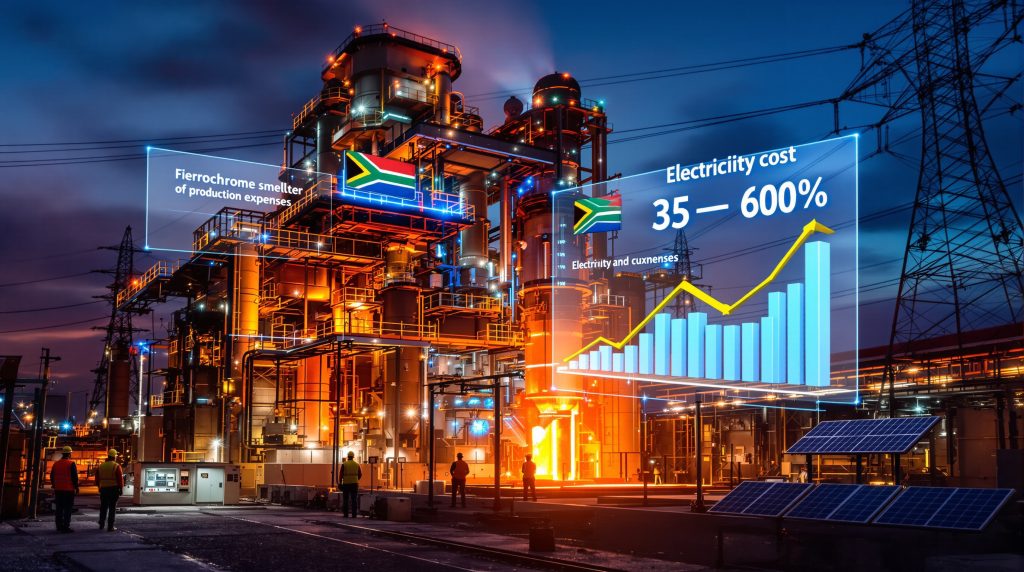Electricity Packages for Ferrochrome Smelters: Government Initiatives and Industry Impact
In the energy-intensive world of ferrochrome production, electricity costs represent a critical factor that can make or break operational viability. Specialized electricity packages have emerged as essential tools for supporting this strategic industry, balancing the needs of producers with broader economic and energy management objectives.
What Are Electricity Packages for Ferrochrome Smelters?
Electricity packages for ferrochrome smelters represent specialized tariff structures designed specifically to address the unique and substantial power requirements of ferrochrome production. These arrangements typically feature preferential electricity rates, consumption-based incentives, and tailored power agreements that acknowledge the energy-intensive nature of ferrochrome smelting operations.
The South African government has recently confirmed the development of a specialized electricity package for the ferrochrome sector that goes beyond the standard negotiated pricing agreement (NPA) framework available to other electricity-intensive enterprises. This initiative involves "significant concessions" that required Cabinet approval due to their departure from standard regulatory parameters.
Understanding Electricity Packages in the Context of Ferrochrome Production
Ferrochrome producers face exceptional electricity demands that distinguish them from other industrial operations. Standard electricity pricing models often fail to accommodate these unique requirements, necessitating specialized packages that can support industry viability while still meeting grid management objectives.
The standard NPA framework in South Africa requires companies to prove that electricity is a significant driver of operating costs and that they consume a minimum of 80 GWh yearly at a load factor greater than 70%. The new ferrochrome-specific package acknowledges that even these parameters may be insufficient for this particularly energy-intensive sector.
The Critical Role of Electricity in Ferrochrome Production
Ferrochrome production ranks among the most electricity-intensive industrial processes in the world. The smelting process requires maintaining extreme temperatures for extended periods, creating power demands that dwarf those of many other manufacturing processes.
With electricity representing a dominant portion of production expenses, even modest changes in electricity pricing can dramatically impact operational viability and global competitiveness. This reality has pushed governments in ferrochrome-producing countries to develop specialized approaches to electricity pricing for this strategic sector.
Why Are Special Electricity Packages Necessary?
The development of specialized electricity packages stems from recognition that standard industrial tariffs can render ferrochrome production economically unviable, particularly in regions with high baseline electricity costs.
Economic Pressures Facing the Ferrochrome Industry
Ferrochrome producers operate in a highly competitive global market characterized by price volatility and thin margins. When electricity costs rise significantly, producers can quickly find themselves unable to compete with operations in regions with lower energy costs.
In South Africa, Minister Ramokgopa noted that the industry had raised serious concerns about "the negative impact that high electricity tariffs were having on the viability of the smelters." This recognition prompted the government to pursue a specialized solution that could preserve this strategically important industry.
Employment and Economic Multiplier Effects
The ferrochrome industry creates substantial direct and indirect employment opportunities. When smelters close or reduce operations due to high electricity costs, the impacts extend far beyond the immediate job losses, affecting entire communities and regional economies.
The South Africa beneficiation strategy recognizes this importance, with Minister Ramokgopa confirming meetings with major labor unions including the National Union of Mineworkers, the National Union of Metalworkers of South Africa, and Solidarity, whose members had received Section 189 retrenchment notices from some smelters. The minister explicitly stated that priority was being given to "salvaging jobs at the smelters" and protecting the South African economy.
Key Components of Effective Electricity Packages
Successful electricity packages for ferrochrome producers typically incorporate several key elements that address both the industry's needs and broader energy system objectives.
Negotiated Pricing Agreements (NPAs)
NPAs form the foundation of many electricity packages for ferrochrome producers. These agreements provide discounted electricity tariffs in exchange for the smelter's flexibility in power usage patterns.
In South Africa, the standard NPA framework arises from a government policy decision to provide qualifying companies with incentivized tariffs, paid for by standard tariff customers. However, the recently developed ferrochrome package goes beyond these standard parameters, recognizing the exceptional challenges facing this specific industry.
Consumption-Based Incentives
Effective electricity packages often include tiered pricing structures that recognize the economies of scale inherent in ferrochrome production. These approaches can help smelters optimize their operations while providing predictability for power utilities.
For ferrochrome producers, consumption-based incentives acknowledge that higher utilization rates generally correlate with greater operational efficiency, benefiting both the producer and the broader economy.
Energy Efficiency Support Mechanisms
Modern electricity packages increasingly incorporate incentives for energy efficiency improvements. By rewarding reductions in energy intensity, these mechanisms can simultaneously support industry competitiveness and broader energy transition insights and objectives.
Energy efficiency support represents a win-win approach, reducing both production costs and environmental impacts while potentially freeing up generation capacity for other users.
Load Management Programs
Load management components allow smelters to adjust their electricity consumption patterns to benefit both their operations and the broader electricity grid. This flexibility can provide significant value to grid operators, particularly in systems facing capacity constraints.
In South Africa, where the power system has faced significant challenges in recent years, the ability of large industrial consumers like ferrochrome smelters to modify their consumption patterns during periods of system stress represents a valuable resource for grid managers.
Case Study: South Africa's Approach to Ferrochrome Electricity Packages
South Africa provides an instructive example of how governments can approach electricity pricing for strategic industries like ferrochrome production.
Current Challenges in South Africa's Ferrochrome Sector
South Africa's ferrochrome industry has faced mounting challenges in recent years, with several facilities either closing or reducing operations. High electricity costs combined with supply reliability issues have eroded the country's traditional competitive advantages in this sector.
These challenges have prompted direct intervention at the ministerial level, with Electricity and Energy Minister Kgosientsho Ramokgopa securing Cabinet approval to negotiate directly with the industry alongside the national power utility, Eskom.
The Government's Response
The South African government has recognized the strategic importance of the ferrochrome industry and is developing a specialized electricity package that includes "significant concessions" outside the standard NPA framework.
As part of the discussions with the ferrochrome sector, feedback has been gathered on electricity requirements for both sustaining existing operations and potentially reactivating mothballed facilities. This approach demonstrates a comprehensive effort to preserve and potentially expand the industry's contribution to the economy.
Ministerial Intervention and Cabinet Approval
The high-level nature of South Africa's intervention underscores the strategic importance attached to preserving ferrochrome production capacity. Minister Ramokgopa has secured Cabinet approval to negotiate directly with the industry alongside Eskom, indicating top-level government commitment to finding a workable solution.
This ministerial involvement reflects recognition that standard regulatory approaches may be insufficient to address the exceptional challenges facing this particular industry.
Union Engagement and Job Preservation Focus
The South African government has engaged directly with major labor unions whose members are employed in the ferrochrome sector. This engagement demonstrates the social dimension of industrial electricity pricing decisions and the broader impacts they can have on communities and regional economies.
Minister Ramokgopa has emphasized that "we are going to protect and save the South African economy," highlighting the connection between supporting strategic industries and broader economic objectives.
Global Benchmarking and Competitive Considerations
Ferrochrome producers operate in a global market, making international competitiveness a central consideration in electricity pricing decisions.
International Comparisons of Electricity Pricing for Ferrochrome Producers
Globally, ferrochrome producers face vastly different electricity costs depending on their location. Countries with abundant hydroelectric power or other low-cost energy sources often enjoy significant competitive advantages in energy-intensive industries like ferrochrome production.
These international cost differentials create challenges for producers in regions with higher electricity costs, necessitating policy interventions to maintain industrial competitiveness.
The Impact of Electricity Costs on Global Competitiveness
With electricity representing such a substantial portion of production costs, even modest differences in electricity pricing can determine whether a ferrochrome facility remains viable in the international market.
This reality creates difficult policy choices for governments, particularly in regions where electricity costs are rising due to factors like fuel price increases, carbon pricing, or infrastructure investment needs.
Balancing Industry Support with Market Principles
Policymakers must balance the need to support strategic industries like ferrochrome production with broader economic and market considerations. Electricity packages must be structured to provide meaningful relief to producers without creating market distortions or placing undue burdens on other electricity consumers.
This balancing act requires careful policy design and ongoing engagement with stakeholders throughout the electricity system and broader economy.
Technological Innovations Reducing Electricity Dependency
While specialized electricity packages represent an important policy tool, technological innovation offers a complementary pathway to improving the competitiveness of ferrochrome production.
Breakthrough Technologies in Ferrochrome Production
The ferrochrome industry has been pursuing mining innovation trends to reduce electricity consumption while maintaining product quality. These efforts recognize that improving energy efficiency represents a sustainable pathway to enhanced competitiveness.
Advances in process technologies, furnace design, and recovery systems continue to offer opportunities for reducing the electricity intensity of ferrochrome production.
Energy Efficiency Improvements in Furnace Design
Modern furnace designs incorporate numerous energy efficiency features that can significantly reduce electricity consumption. These innovations represent important investments in long-term competitiveness, reducing vulnerability to electricity price fluctuations.
For ferrochrome producers, energy efficiency improvements can complement favorable electricity pricing to create a more sustainable competitive position.
Alternative Energy Integration Opportunities
Some ferrochrome producers are exploring opportunities to integrate alternative energy sources into their operations. While the core smelting process currently requires grid electricity due to its extreme power demands, supplementary processes may be powered by on-site generation or renewable sources.
These approaches can reduce overall grid dependency and potentially qualify producers for additional incentives related to renewable energy or carbon reduction.
How Do Electricity Packages Benefit the Broader Economy?
Beyond their direct impact on ferrochrome producers, specialized electricity packages can generate broader economic benefits that justify their implementation.
Preserving Vertical Integration in the Chrome Value Chain
Electricity packages that support domestic ferrochrome production help preserve vertical integration in the chrome value chain. This integration creates higher value from mineral resources compared to exporting raw chromite ore, generating greater economic returns and employment opportunities.
For resource-rich countries like South Africa, maintaining downstream processing capabilities represents an important economic development strategy.
Maintaining Industrial Capabilities and Knowledge Base
The specialized knowledge and industrial capabilities associated with ferrochrome production represent valuable national assets. Electricity packages that help sustain these operations prevent the loss of these capabilities, which would be difficult and costly to rebuild once lost.
This preservation of industrial capabilities supports broader industrial development objectives and maintains options for future economic growth.
Supporting Related Industries and Supply Chains
Ferrochrome smelters support extensive supply chains, including mining operations, refractory manufacturers, equipment suppliers, and logistics providers. Electricity packages that keep smelters operational help maintain these broader industrial ecosystems.
Minister Ramokgopa's emphasis on protecting and saving the South African economy reflects this recognition of the ferrochrome industry's broader economic significance.
Implementation Challenges and Considerations
Implementing specialized electricity packages involves navigating several complex challenges and balancing diverse stakeholder interests.
Regulatory Approval Processes
Specialized electricity packages typically require regulatory approval, which can involve complex processes and multiple stakeholders. In South Africa, the ferrochrome package required Cabinet approval because it involved "significant concessions" outside the parameters of the standard NPA framework approved by the National Energy Regulator of South Africa.
Navigating these approval pathways efficiently is essential to providing timely relief to struggling producers.
Balancing Stakeholder Interests
Effective electricity packages must balance the interests of multiple stakeholders, including ferrochrome producers, power utilities, other electricity consumers, labor unions, and environmental advocates.
Minister Ramokgopa's intention to meet with other energy-intensive subsectors to explain why the ferrochrome sector was being prioritized demonstrates recognition of these broader stakeholder considerations.
Monitoring and Adjustment Mechanisms
Once implemented, electricity packages require ongoing monitoring and periodic adjustments to ensure they remain effective and appropriate as market conditions evolve.
The South African approach includes assessment of Eskom's capacity to deliver the required electricity "for a sustained period of at least five years," demonstrating consideration of long-term viability and sustainability transformation.
Future Outlook for Ferrochrome Electricity Packages
The future of electricity packages for ferrochrome producers will likely be shaped by several emerging trends and considerations.
Trends in Energy Policy for Energy-Intensive Industries
Energy policies for energy-intensive industries like ferrochrome production are evolving globally. Emerging trends include greater integration of demand response capabilities, increased emphasis on energy efficiency, and growing consideration of carbon intensity in electricity pricing structures.
These trends will influence the design and implementation of future electricity packages for ferrochrome producers.
The Role of Renewable Energy in Future Ferrochrome Production
As renewable energy technologies continue to advance and costs decline, opportunities to incorporate these sources into ferrochrome production may expand. Future electricity packages may increasingly incentivize the integration of renewable energy alongside traditional grid power.
This evolution could help align industry support with broader energy transition objectives, creating more sustainable pathways for ferrochrome production.
Long-term Sustainability Considerations
The long-term sustainability of specialized electricity packages for ferrochrome producers depends on their ability to drive continuous improvement in energy efficiency and overall competitiveness.
Minister Ramokgopa's reference to recent improvements in the energy availability factor of South Africa's coal fleet, noting that "we are leaving megawatts on the floor," suggests potential for more sustainable electricity supply arrangements as system constraints ease.
Balancing Industry Support with Energy Transition Goals
Specialized electricity packages for ferrochrome smelters represent an important policy tool for supporting this strategically important industry. When well-designed, these packages can help preserve jobs, maintain industrial capabilities, and support broader economic objectives while encouraging progress toward greater energy efficiency.
The South African government's approach, focusing on both immediate job preservation and longer-term industry viability, demonstrates how electricity pricing policy can address multiple objectives simultaneously. By measuring industry requirements against power utility capacity and engaging with affected stakeholders, this approach seeks to create sustainable solutions that benefit both the industry and broader economy.
As governments continue to refine these approaches, finding the right balance between providing necessary support to energy-intensive industries and advancing broader steel tariff impacts will remain a key challenge. Success will require ongoing collaboration between industry, government, labor, and other stakeholders to develop solutions that address immediate needs while building toward a more sustainable future.
Ready to Capitalise on Major Mineral Discoveries?
Don't miss the next significant ASX discovery opportunity when it breaks! Discovery Alert's proprietary Discovery IQ model delivers instant alerts on potentially lucrative mineral finds, helping investors act before the market fully responds. Explore why historic discoveries can generate substantial returns by visiting our dedicated discoveries page and begin your 30-day free trial today.




